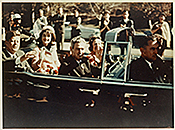
Warren Commission - Introduction
President Lyndon B. Johnson appointed the President's Commission on the Assassination of President Kennedy, commonly called the Warren Commission, by Executive Order (E.O. 11130) on November 29, 1963. Its purpose was to investigate the assassination of President John Fitzgerald Kennedy on November 22, 1963, at Dallas, Texas. President Johnson directed the Commission to evaluate matters relating to the assassination and the subsequent killing of the alleged assassin, and to report its findings and conclusions to him.
The following members served on the Commission:
- Earl Warren, Chief Justice of the United States, former Governor and attorney general of California, Chair;
- Richard B. Russell, Democratic Senator from Georgia and chairman of the Senate Armed Services Committee, former Governor of Georgia, and county attorney in that State;
- John Sherman Cooper, Republican Senator from Kentucky, former county and circuit judge in Kentucky, and United States Ambassador to India;
- Hale Boggs, Democratic Representative from Louisiana and majority whip in the House of Representatives;
- Gerald R. Ford, Republican Representative from Michigan and chairman of the House Republican Conference;
- Allen W. Dulles, lawyer and former Director of the Central Intelligence Agency;
- John J. McCloy, lawyer, former President of the International Bank for Reconstruction and Development, and former United States High Commissioner for Germany.
On December 13, 1963, Congress passed Senate Joint Resolution 137 (Public Law 88-202) authorizing the Commission to subpoena witnesses and obtain evidence concerning any matter relating to the investigation. The resolution also gave the Commission the power to compel the testimony of witnesses by granting immunity from prosecution to witnesses testifying under compulsion. The Commission, however, did not grant immunity to any witness during the investigation.
The Commission acted promptly to obtain a staff to meet its needs. J. Lee Rankin, former Solicitor General of the United States, was sworn in as general counsel for the Commission on December 16, 1963. He was aided in his work by 14 assistant counsel who were divided into teams to deal with the various subject areas of the investigation. The Commission was also assisted by lawyers, Internal Revenue Service agents, a senior historian, an editor, and secretarial and administrative personnel who were assigned to the Commission by Federal agencies at its request. Officials and agencies of the state of Texas, as well as of the Federal Government, fully cooperated with the Commission on its work.
From the first, the Commission considered its mandate to conduct a thorough and independent investigation. The Commission reviewed reports by the Federal Bureau of Investigation, Secret Service, Department of State, and the Attorney General of Texas, and then requested additional information from federal agencies, Congressional committees, and state and local experts. The Commission held hearings and took the testimony of 552 witnesses. On several occasions, the Commission went to Dallas to visit the scene of the assassination and other places.
The Commission presented its Report, in which each member concurred, to the President on September 24, 1964. The publication of the Report was soon followed by the publication of the 26 volumes of the Commission's Hearings. The Commission then transferred its records to the National Archives to be permanently preserved under the rules and regulations of the National Archives and applicable federal law.
In the National Archives, the records of the Warren Commission comprise Record Group 272: Records of the President's Commission on the Assassination of President Kennedy. The record group contains about 363 cubic feet of records and related material. Approximately 99 percent of these records are currently open and available for research. The records consist of investigative reports submitted by the Federal Bureau of Investigation, the Secret Service, and the Central Intelligence Agency; various kinds of documents such as income tax returns, passport files, military and selective service records, and school records relating to Lee Harvey Oswald and Jack Ruby; transcripts of testimony, depositions, and affidavits of witnesses, correspondence; manuals of procedures of federal agencies; administrative memorandums; records relating to personnel; fiscal records; agenda, proceedings, and minutes of Commission meetings and minutes of staff meetings; exhibits; tape records, newspaper and press clippings, and films; indexes; drafts and printer's proofs of the Report and Hearings of the Commission; a chronology of events in the lives of Oswald, Ruby, and others, 1959-1963; records relating to the interrogation and trial of Jack Ruby; and other records. Most of these records relate to the period of the investigation of President Kennedy's assassination, November 1963 to September 1964, but some records of earlier and a few later dates are included.
The Kennedy family donated the autopsy X-rays and photographs to the National Archives under an agreement dated October 29, 1966. The agreement limits access to these materials to
- persons authorized to act for a Committee of Congress, a Presidential commission, or any other official agency of the federal government having authority to investigate matters relating to the assassination of President Kennedy or
- recognized experts in the field of pathology or related areas of science and technology whose applications are approved by the designated Kennedy family representative.
